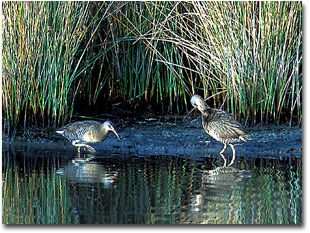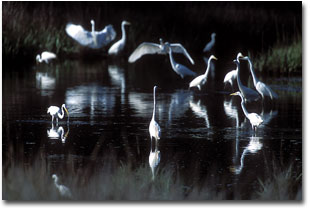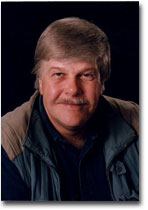|
|
 The Camera Hunter® As Wild as It Ever Gets Photography and Text Copyright Bill Silliker, Jr. If Ponce De Leon in his steel hat had stepped out of the woods, I wouldn’t have been surprised. Actually, that 16th century Spanish explorer never got as far north as the barrier island off the coast of Savannah, Georgia whose treasures I was discovering. Not the least of those is a primeval forest. Huge live oaks, monster magnolias and towering loblolly pines, many laced with Spanish moss, provide a formidable canopy for much of the island. These wondrous trees, cloaked by an under story of cabbage palms, palmetto trees and a variety of other sub tropical plants, give the island a wild feeling like no other place this camera hunter has ever stepped into on the south coast of North America.
Wassaw Island Most of Wassaw Island is a national wildlife refuge, thanks to the conservation awareness of its former owners and the generosity of The Nature Conservancy. The Parsons family of Kennebunk, Maine preserved it as an unspoiled wilderness for over 100 years before selling it to The Nature Conservancy in 1969 at a price well below market value to insure its preservation in the face of growing development pressure. The Nature Conservancy donated it to the U.S. Fish & Wildlife Service to manage the island, especially for the loggerhead turtles that lay eggs on its deserted beaches each summer. The approximately 10,000-acre Wassaw Island National Wildlife Refuge has 7 miles of beach, a virgin forest and large salt marshes with meandering creeks. Day use for bird watching, hiking, fishing and other low impact activities is permitted. A special permit to hunt deer is also permitted. Outside of a few trails and handful of buildings built by the Parsons family, the island remains as wild as when the Spanish explorers combed similar Southern forests in search of gold and other riches - not to mention Ponce de Leon’s “Fountain of Youth”. Birds Galore While finding a fountain of youth might seem like a good idea on some days, the purpose of this trip was to capture the essence of this wilderness for a bird magazine assignment with friend J. Dwight. The Parsons Family Trust retained approximately 200 acres with several lodging buildings in private ownership. Family members and their guests are the only people who can stay overnight on the island. A member of the Parsons family, J. had invited me to explore Wassaw Island’s special magic, which for him centers on its many migratory and resident birds. Because J. is a consummate birder, he even helped add several new species to my files. Dawn shoots on the island provided a sampling of what Wassaw Island offers the camera hunter. Egrets, herons, anhinga and cormorants regularly posed at marsh ponds. As the light got better, I followed with shots of black skimmers, 4 different species of tern, red knots, sanderlings, brown pelicans, laughing gulls and more on the beaches.
Wild Behavior Most birds on Wassaw Island showed little concern at the sight of humans and many permitted an approach for effective photography without the use of camouflage or a blind. The gray squirrels of Wassaw Island, however, set me to musing about what wild really means. Introduced in the 19th century by George Parsons, they remain numerous today. However, the gray squirrels of Wassaw Island are seldom seen ghosts of its primeval forest. The squirrels were heavily hunted here before refrigeration made them less needed as a food source. As one who has to chase squirrels away from my bird feeders, I was amazed that no squirrel dared show itself at the island caretakers’ feeder. And so I began to ponder that the learned behavior of Wassaw Island’s squirrels, taught from generation to generation, is to fear man. How else can one explain the fact that, despite five days on the island, we only caught fleeting glimpses of them? While a number of whitetail deer also inhabit the island, you would not know that either except for the fresh tracks that they leave on the beach each morning. Journals kept by 19th century family members indicate that garrisons of troops stationed at a small fort on the beach during the Civil War and Spanish American War hunted them heavily as well, and limited hunting is permitted today. Those who say that it’s natural for wild animals to fear humans as predators should consider the hunting epic from Ernest Hemingway, Green Hills of Africa. Hemingway kept looking for a country that hadn’t been previously hunted, because the animals had “little sophistication” and would stand and watch as his hunting party approached. Hemingway found his prize – a large kudu bull - in those remote green hills. And in a strange way, I found mine in the Parsons family library on Wassaw Island. Stocked with classics from the 1800’s on, many of the books concern nature. In one written in 1916 by Edward W. Nelson, then Chief of the U.S. Bureau of Biological Survey, predecessor to the U.S. Fish and Wildlife Service, the following words documented something that this camera hunter has long suspected: “Many of the chronicles dealing with explorations and life on the frontier during the early period of the occupation of America give interesting details concerning the game animals. Allouez says that in 1680 between Lake Erie and Lake Michigan the prairies were filled with an incredible number of bears, wapiti, white-tailed deer, and turkeys on which the wolves made fierce war. He adds that on a number of occasions the game was so little wild that it was necessary to fire shots to protect the party from it.” Catch yours in the good light. BS-NPN 012 Editor's Note - Join Bill Silliker for a special wildlife photography workshop offered by the Maine Photographic Workshops July 21 - 27, 2002. Bill will teach serious nature photographers how to combine photographic skills with those of the hunter. Learn how to find wild subjects, evaluate an animal's behavior, use camouflage and various blinds, wildlife approach techniques and more. For information, query The Mooseman at mooseman@mainecoast.net. Comments on this column? Send them to the editor.
Bill has been an instructor of wildlife and nature photography with L. L. Bean's Outdoor Discovery Program since 1992 and is a member of the Fuji Film Talent Team. Bill is a past Board member of the North American Nature Photography Association (NANPA) and a professional member of the Outdoor Writer's Association of America (OWAA). He maintains a web site with tips for wildlife photographers at www.camerahunter.com and is editor of a site for all wildlife enthusiasts at www.wildlifewatcher.com. Bill's work with moose has been featured on National Public Radio's "Living On Earth", his book on bald eagles was featured on CSPAN's "Book TV" and his Daybreak 2000 image of the Millennium's dawn on NBC's "Today Show". To see the 2002 dates for Bill's slide talks for camera clubs sponsored by Fujifilm Professional, as well as a schedule of Bill's book signings and workshops with L.L. Bean, Great American Photography Weekend and The Maine Photographic Workshops, click here. |
|
|
 A recent visit there left me pondering what wild really means. We’ll explore that in a moment. First, let’s look at why Wassaw Island is the kind of a place where one expects to see a Spanish Conquistador.
A recent visit there left me pondering what wild really means. We’ll explore that in a moment. First, let’s look at why Wassaw Island is the kind of a place where one expects to see a Spanish Conquistador. Afternoons, I worked Eastern bluebirds at the family compound and a variety of warblers and other songbirds from a treetop level “widow’s walk” on the roof of one of the buildings where family members have stayed for over a century while hunting, fishing or vacationing.
I also had the opportunity to shoot bald eagles, osprey and even the seldom seen, clapper rail.
Afternoons, I worked Eastern bluebirds at the family compound and a variety of warblers and other songbirds from a treetop level “widow’s walk” on the roof of one of the buildings where family members have stayed for over a century while hunting, fishing or vacationing.
I also had the opportunity to shoot bald eagles, osprey and even the seldom seen, clapper rail. Maine wildlife & nature photographer Bill Silliker, Jr. - The Camera Hunter® - has photographed at many wild places in North America, with the results published in Audubon, Backpacker, Field & Stream; National Wildlife, Outdoor Photographer, Outdoor Life, Sports Afield and many other magazines; in exclusive calendar projects on loons, moose, wildlife and Maine's Baxter State Park, and in his books: Just Eagles; Uses For Mooses; Moose: Giants of the Northern Forest; Just Loons; and Maine Moose Watcher's Guide and his latest book, available in July 2002, Saving Maine:An Album of Conservation Success Stories.
Maine wildlife & nature photographer Bill Silliker, Jr. - The Camera Hunter® - has photographed at many wild places in North America, with the results published in Audubon, Backpacker, Field & Stream; National Wildlife, Outdoor Photographer, Outdoor Life, Sports Afield and many other magazines; in exclusive calendar projects on loons, moose, wildlife and Maine's Baxter State Park, and in his books: Just Eagles; Uses For Mooses; Moose: Giants of the Northern Forest; Just Loons; and Maine Moose Watcher's Guide and his latest book, available in July 2002, Saving Maine:An Album of Conservation Success Stories.